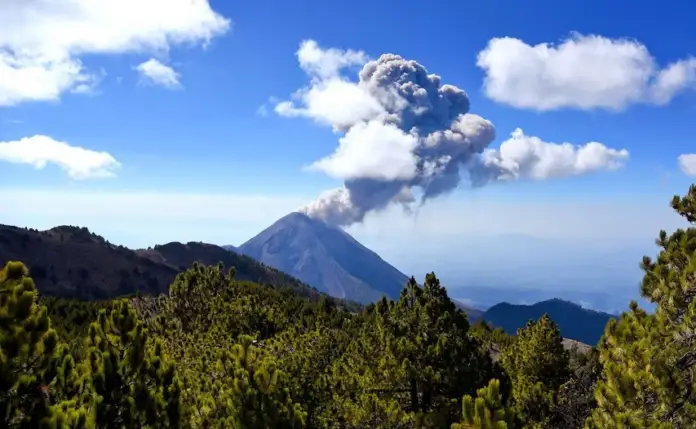
The Colima Volcano, also known as the Volcano of Fire of Colima, located in the western area of the Trans-Mexican Volcanic Belt (CVT), is in passive degassing.
Cloudy sky, no visibility towards the area of the volcano, which would make observation difficult in the event of an exhalation of water vapor, gas and/or ash, (Image 1, webcam network). The volcano is in the passive degassing stage
More information in the weekly technical bulletin of the Colima volcano, from the University Center for Volcanological Studies of the University of Colima (UCOL-CUEV).
Virtual radiosonde (based on GFS 12Z model) of Manzanillo Colima, 06:00 am local time, October 25, 2024:
At 5000 m: Wind from the east-northeast of 4.5 km/h.
Between 5000 and 7000 m: Northwest wind 16 km/h.
Above 7000 m: North-northwest wind 36 km/h.
There is cloud cover over the volcano area, which would hinder satellite detection in the event of any activity (Image 2). The satellite estimate of rainfall does not show accumulated precipitation in the volcano area in the last three hours, this with a cutoff at 12:00 h today, local time (Image 3).
Ash trajectory
In the event of any exhalation of volcanic ash, gas and/or water vapor, the trajectory forecast of the Hysplit (Hybrid Single-Particle Lagrangian Integrated Trajectory) model, executed at CONAGUA-CGSMN with a possible emission height of 500 meters above the volcanic cone which is 3,839 meters AMSL “above mean sea level” (2,745 meters AGL “above ground level”), indicates trajectories to the south and south-southwest, changing to west-southwest (simulating exhalation every next hour, 6), as it passes through the northeast, north, center, center-west, south and southwest of the state of Colima; southern area of the state of Jalisco and over the Pacific Ocean, for the first 12 hours of the forecast, (14:00 to 02:00 local time of the following day). Later, for the last 12 hours of the forecast (02:00 to 14:00 local time of the following day), the trajectories will continue over the Pacific Ocean where they will end. These trajectories predict the main direction of emissions of the plume of gas, water vapor and/or volcanic ash, coming from the Volcano of Fire of Colima.
The legend behind the volcano
The Volcano of Colima, also called Volcano of Fire, rises majestically in the Mexican landscape. (Cuartoscuro)
The Volcano of Colima, also called Volcano of Fire, rises majestically in the Mexican landscape. (Cuartoscuro)
The legend has its roots in the colonial period, in the kingdom of Colliman, which in ancient language meant “the place where the old god or the god of fire dominates”, territory where the volcano of fire and the snowy mountain are located. On the slopes of the volcano of fire a splendid palace was erected, home of the king and his court. During a meeting between the Viceroy of New Spain and the monarch of Colliman, the details of which are unknown, the enraged viceroy left the palace and ordered a military siege, preventing any individual from leaving.
As the days passed, the lack of water and food began to affect the besieged, hitting the king and his entourage hard. At night, the king tried to lead an escape, which failed when they were discovered by the Spanish forces. In a desperate act, the royal entourage climbed to the top of the volcano. Unable to flee, they chose to throw themselves into the crater, losing their lives as martyrs and sowing a legacy of pride among their descendants.
Since then, the volcano erupts every time a descendant of Colliman suffers injustice, perpetuating the memory of that heroic act.
Source: infobae






